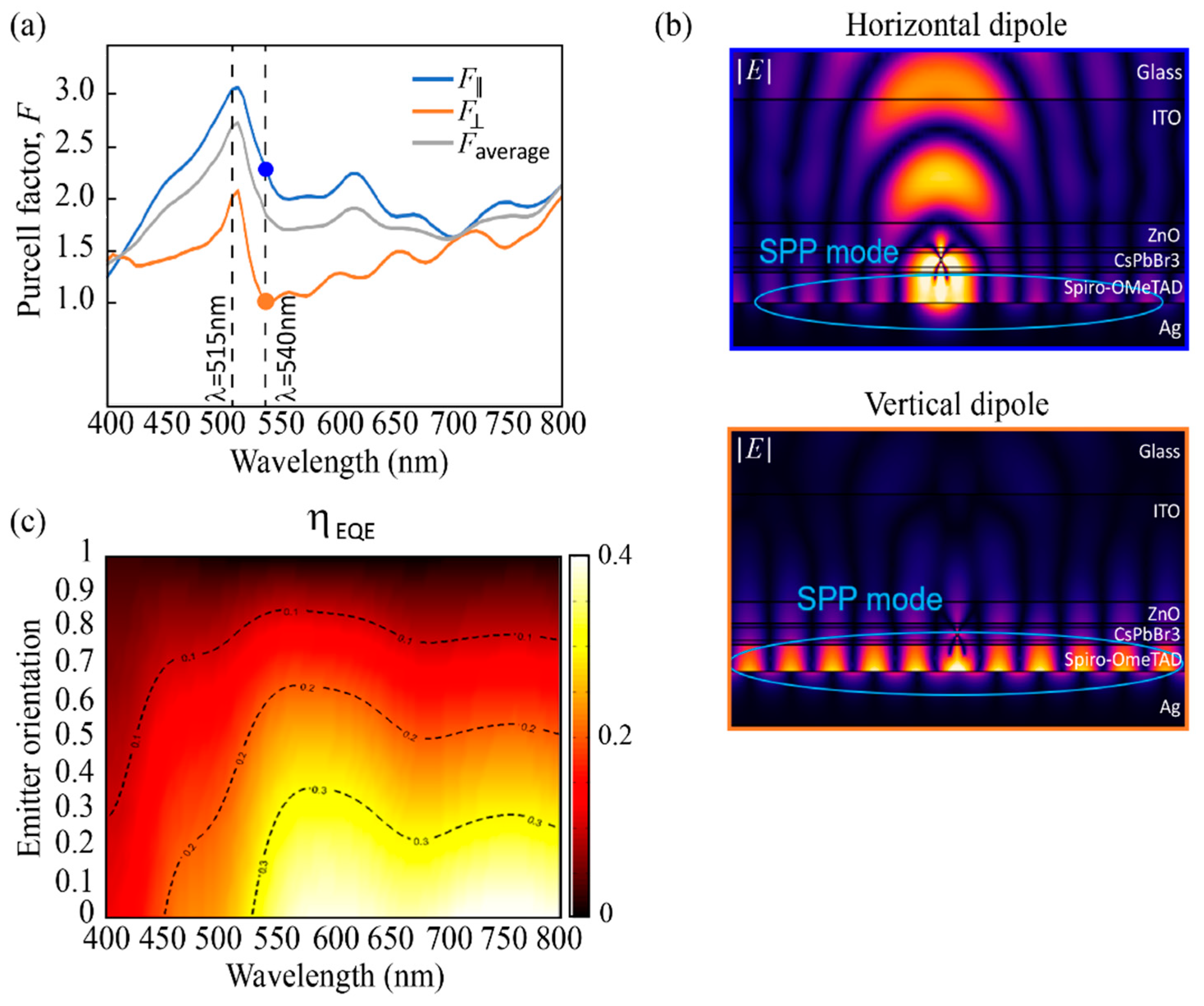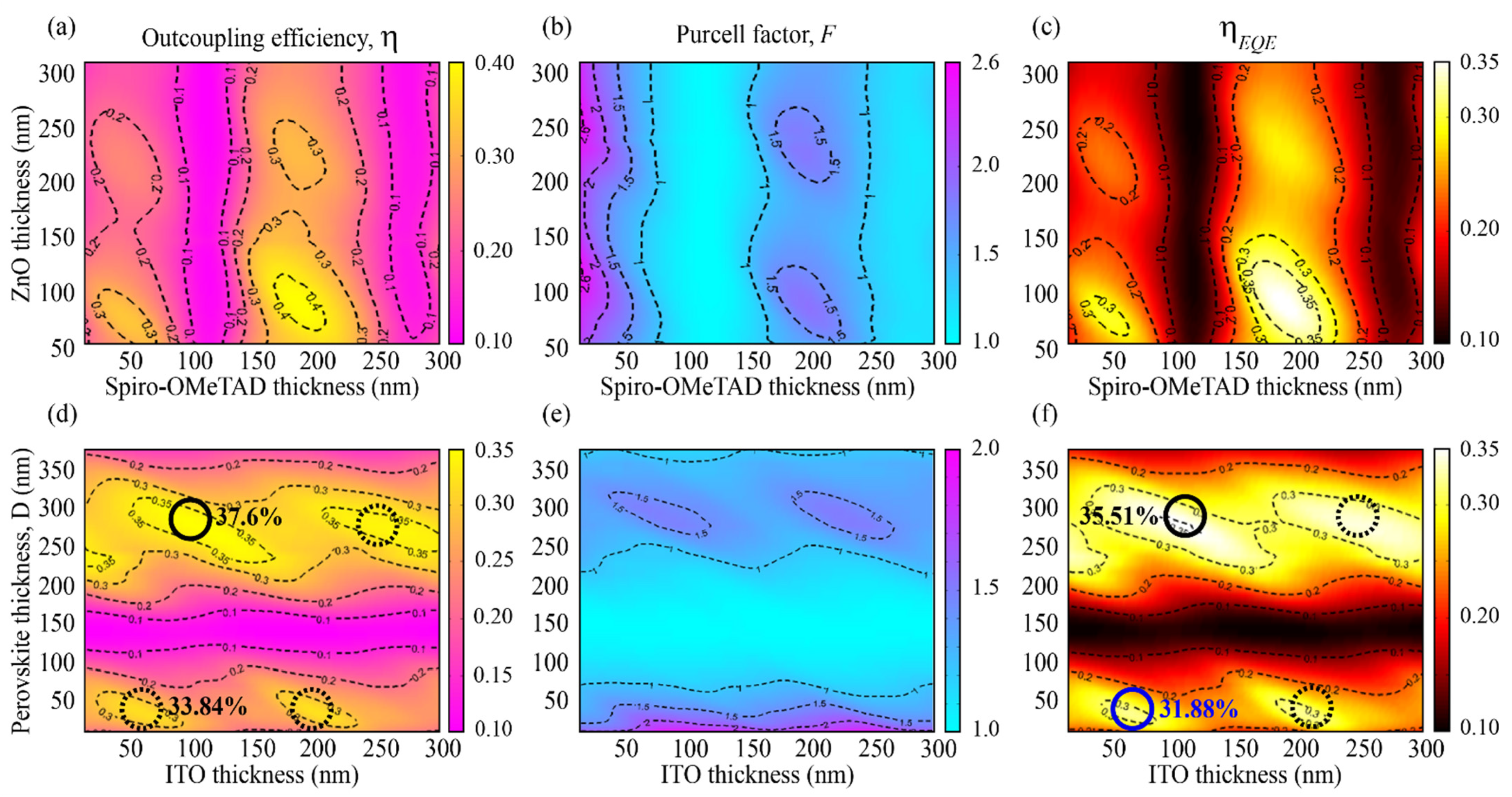Photonic Cavity Effects for Enhanced Efficiency in Layered Perovskite-Based Light-Emitting Diodes
Abstract
:1. Introduction
2. Results and Discussion
3. Conclusions
Supplementary Materials
Author Contributions
Funding
Institutional Review Board Statement
Informed Consent Statement
Data Availability Statement
Conflicts of Interest
References
- Park, M.; Roh, J.; Lim, J.; Lee, H.; Lee, D. Double Metal Oxide Electron Transport Layers for Colloidal Quantum Dot Light-Emitting Diodes. Nanomaterials 2020, 10, 726. [Google Scholar] [CrossRef] [PubMed] [Green Version]
- Kim, H.-M.; Jeong, W.; Kim, J.H.; Jang, J. Stability of Quantum-Dot Light Emitting Diodes with Alkali Metal Carbonates Blending in Mg Doped ZnO Electron Transport Layer. Nanomaterials 2020, 10, 2423. [Google Scholar] [CrossRef] [PubMed]
- Luo, D.X.; Xiao, Y.; Hao, M.; Zhao, Y.; Yang, Y.B.; Gao, Y.; Liu, B.Q. Doping-free white organic light-emitting diodes without blue molecular emitter: An unexplored approach to achieve high performance via exciplex emission. Appl. Phys. Lett. 2017, 110, 061105. [Google Scholar] [CrossRef]
- Zhuang, S.W.; Ma, X.; Hu, D.Q.; Dong, X.; Zhang, Y.T.; Zhang, B.L. Green perovskite light emitting diodes based on the ITO/Al2O3/CsPbBr3 heterojunction structure. Opt. Mater. 2018, 77, 25–29. [Google Scholar] [CrossRef]
- Oh, M.; Jo, S.I.; Parida, B.; Singh, A.; Ko, K.; Kang, J.W.; Kim, H. Electrical, Optical, and Structural Characteristics of CH3NH3PbI3 Perovskite Light-Emitting Diodes. Phys. Status Solidi A 2018, 215, 1701014. [Google Scholar] [CrossRef]
- Kim, Y.H.; Kim, S.; Kakekhani, A.; Park, J.; Lee, Y.H.; Xu, H.; Negane, S.; Wexler, R.B.; Kim, D.H.; Jo, S.H.; et al. Comprehensive defect suppression in perovskite nanocrystals for high-efficiency light-emitting diodes. Nat. Photonics 2021, 15, 148–155. [Google Scholar] [CrossRef]
- Kumawat, N.K.; Liu, X.K.; Kabra, D.; Gao, F. Blue perovskite light-emitting diodes: Progress, challenges and future directions. Nanoscale 2019, 11, 2109–2120. [Google Scholar] [CrossRef] [Green Version]
- Shen, Y.; Cheng, L.P.; Li, Y.Q.; Li, W.; Chen, J.D.; Lee, S.T.; Tang, J.X. High-Efficiency Perovskite Light-Emitting Diodes with Synergetic Outcoupling Enhancement. Adv. Mater. 2019, 31, 1901517. [Google Scholar] [CrossRef]
- Park, C.H.; Kang, S.W.; Jung, S.G.; Lee, D.J.; Park, Y.W.; Ju, B.K. Enhanced light extraction efficiency and viewing angle characteristics of microcavity OLEDs by using a diffusion layer. Sci. Rep. 2021, 11, 3430. [Google Scholar] [CrossRef]
- Liu, B.; Altintas, Y.; Wang, L.; Shendre, S.; Sharma, M.; Sun, H.; Mutlugun, E.; Demir, H.V. Record High External Quantum Efficiency of 19.2% Achieved in Light-Emitting Diodes of Colloidal Quantum Wells Enabled by Hot-Injection Shell Growth. Adv. Mater. 2020, 32, 1905824. [Google Scholar] [CrossRef]
- Meng, S.S.; Li, Y.Q.; Tang, J.X. Theoretical perspective to light outcoupling and management in perovskite light-emitting diodes. Org. Electron. 2019, 61, 351–358. [Google Scholar] [CrossRef]
- Wang, K.; Ecker, B.; Huang, J.; Gao, Y. Evaporation of Methylammonium Iodide in Thermal Deposition of MAPbI3. Nanomaterials 2021, 11, 2532. [Google Scholar] [CrossRef]
- Tan, Z.K.; Moghaddam, R.S.; Lai, M.L.; Docampo, P.; Higler, R.; Deschler, F.; Price, M.; Sadhanala, A.; Pazos, L.M.; Credgington, D.; et al. Bright light-emitting diodes based on organometal halide perovskite. Nat. Nanotechnol. 2014, 9, 687–692. [Google Scholar] [CrossRef]
- Zou, C.; Lin, L. Effect of emitter orientation on the outcoupling efficiency of perovskite light-emitting diodes. Opt. Lett. 2020, 45, 4786–4789. [Google Scholar] [CrossRef]
- Zhu, R.; Luo, Z.; Wu, S. Light extraction analysis and enhancement in a quantum dot light emitting diode. Opt. Express 2014, 22, A1783–A1798. [Google Scholar] [CrossRef] [PubMed]
- Abdi-Jalebi, M.; Andaji-Garmaroudi, Z.; Cacovich, S.; Stavrakas, C.; Philippe, B.; Richter, J.M.; Alsari, M.; Booker, E.P.; Hutter, E.M.; Pearson, A.J.; et al. Maximizing and stabilizing luminescence from halide perovskites with potassium passivation. Nature 2018, 555, 497–501. [Google Scholar] [CrossRef] [PubMed]
- Liang, H.; Zhu, R.; Dong, Y.; Wu, S.T.; Li, J.; Wang, J.; Zhou, J. Enhancing the outcoupling efficiency of quantum dot LEDs with internal nano-scattering pattern. Opt. Express 2015, 23, 12910–12922. [Google Scholar] [CrossRef] [PubMed] [Green Version]
- Furno, M.; Meerheim, R.; Hofmann, S.; Lussem, B.; Leo, K. Efficiency and rate of spontaneous emission in organic electroluminescent devices. Phys. Rev. B 2012, 85, 115205. [Google Scholar] [CrossRef]
- Braly, I.L.; de Quilettes, D.W.; Pazos-Outón, L.M.; Burke, S.; Ziffer, M.E.; Ginger, D.S. Hybrid perovskite films approaching the radiative limit with over 90% photoluminescence quantum efficiency. Nat. Photonics 2018, 12, 355–361. [Google Scholar] [CrossRef]
- Yan, W.; Mao, L.; Zhao, P.; Mertens, A.; Dottermusch, S.; Hu, H.; Jin, Z.; Richards, B.S. Determination of complex optical constants and photovoltaic device design of all-inorganic CsPbBr3 perovskite thin films. Opt. Express 2020, 28, 15706–15717. [Google Scholar] [CrossRef] [PubMed]
- Aguilar, O.; de Castro, S.; Godoy, M.; Dias, M.R.S. Optoelectronic characterization of Zn1−xCdxO thin films as an alternative to photonic crystals in organic solar cells. Opt. Mater. Express 2019, 9, 3638–3648. [Google Scholar] [CrossRef]
- Jiang, Y.; Almansouri, I.; Huang, S.J.; Young, T.; Li, Y.; Peng, Y.; Hou, Q.; Spiccia, L.; Bach, U.; Cheng, Y.B.; et al. Optical Analysis of Perovskite/Silicon Tandem Solar Cells. J. Mater. Chem. C 2016, 4, 5679–5689. [Google Scholar] [CrossRef]
- Caligiuri, V.; Palei, M.; Imran, M.; Liberato, M.; Krahne, R. Planar Double-Epsilon-Near-Zero Cavities for Spontaneous Emission and Purcell Effect Enhancement. ACS Photonics 2018, 5, 2287–2294. [Google Scholar] [CrossRef]
- Moerland, R.; Hoogenboom, J. Subnanometer-accuracy optical distance ruler based on fluorescence quenching by transparent conductors. Optica 2016, 3, 112–117. [Google Scholar] [CrossRef]
- Rakić, A.D.; Djurišic, A.B.; Elazar, J.M.; Majewski, M.L. Optical Properties of Metallic Films for Vertical-Cavity Optoelectronic Devices. Appl. Opt. 1998, 37, 5271. [Google Scholar] [CrossRef]
- Kluczyk, K.; David, C.; Jacak, J.; Jacak, W. On Modeling of Plasmon-Induced Enhancement of the Efficiency of Solar Cells Modified by Metallic Nano-Particles. Nanomaterials 2019, 9, 3. [Google Scholar] [CrossRef] [PubMed] [Green Version]
- Alabastri, A.; Toma, A.; Malerba, M.; De Angelis, F.; Proietti Zaccaria, R. High temperature nanoplasmonics: The key role of nonlinear effects. ACS Photonics 2015, 2, 115–120. [Google Scholar] [CrossRef]
- van Mensfoort, S.L.M.; Carvelli, M.; Megens, M.; Wehenkel, D.; Bartyzel, M.; Greiner, H.; Janssen, R.A.J.; Coehoorn, R. Measuring the light emission profile in organic light-emitting diodes with nanometre spatial resolution. Nat. Photonics 2010, 4, 329–335. [Google Scholar] [CrossRef]
- Castelli, A.; Meinardi, F.; Pasini, M.; Galeotti, F.; Pinchetti, V.; Lorenzon, M.; Manna, L.; Moreels, I.; Giovanella, U.; Brovelli, S. High-Efficiency All-Solution-Processed Light-Emitting Diodes Based on Anisotropic Colloidal Heterostructures with Polar Polymer Injecting Layers. Nano Lett. 2015, 15, 5455–5464. [Google Scholar] [CrossRef]
- Rastogi, P.; Palazon, F.; Prato, M.; Di Stasio, F.; Krahne, R. Enhancing the Performance of CdSe/CdS Dot-in-Rod Light-Emitting Diodes via Surface Ligand Modification. ACS Appl. Mater. Interface 2018, 10, 5665–5672. [Google Scholar] [CrossRef]
- Zhang, L.; Yang, X.; Jiang, Q.; Wang, P.; Yin, Z.; Zhang, X.; Tan, H.; Yang, Y.M.; Wei, M.; Sutherland, B.R.; et al. Ultra-bright and highly efficient inorganic based perovskite light-emitting diodes. Nat. Comm. 2017, 8, 15640. [Google Scholar] [CrossRef] [PubMed]
- Ban, M.; Zou, Y.; Rivett, J.P.H.; Yang, Y.; Thomas, T.H.; Tan, Y.; Song, T.; Gao, X.; Credgington, D.; Deschler, F.; et al. Solution-processed perovskite light emitting diodes with efficiency exceeding 15% through additive-controlled nanostructure tailoring. Nat. Comm. 2018, 9, 3892. [Google Scholar] [CrossRef] [PubMed] [Green Version]




Publisher’s Note: MDPI stays neutral with regard to jurisdictional claims in published maps and institutional affiliations. |
© 2021 by the authors. Licensee MDPI, Basel, Switzerland. This article is an open access article distributed under the terms and conditions of the Creative Commons Attribution (CC BY) license (https://creativecommons.org/licenses/by/4.0/).
Share and Cite
Lin, L.; Proietti Zaccaria, R.; Garoli, D.; Krahne, R. Photonic Cavity Effects for Enhanced Efficiency in Layered Perovskite-Based Light-Emitting Diodes. Nanomaterials 2021, 11, 2947. https://doi.org/10.3390/nano11112947
Lin L, Proietti Zaccaria R, Garoli D, Krahne R. Photonic Cavity Effects for Enhanced Efficiency in Layered Perovskite-Based Light-Emitting Diodes. Nanomaterials. 2021; 11(11):2947. https://doi.org/10.3390/nano11112947
Chicago/Turabian StyleLin, Lyuye, Remo Proietti Zaccaria, Denis Garoli, and Roman Krahne. 2021. "Photonic Cavity Effects for Enhanced Efficiency in Layered Perovskite-Based Light-Emitting Diodes" Nanomaterials 11, no. 11: 2947. https://doi.org/10.3390/nano11112947
APA StyleLin, L., Proietti Zaccaria, R., Garoli, D., & Krahne, R. (2021). Photonic Cavity Effects for Enhanced Efficiency in Layered Perovskite-Based Light-Emitting Diodes. Nanomaterials, 11(11), 2947. https://doi.org/10.3390/nano11112947







